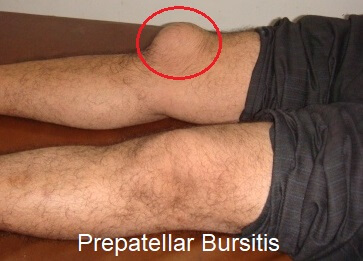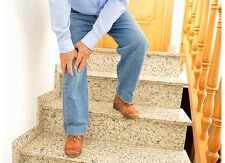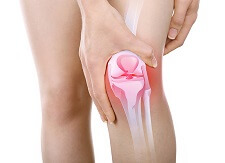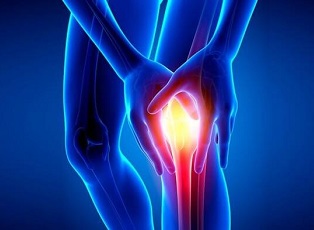- Home
- Knee Joint Anatomy
- Bursa
Knee Bursa
Written By: Chloe Wilson, BSc(Hons) Physiotherapy
Reviewed by: KPE Medical Review Board
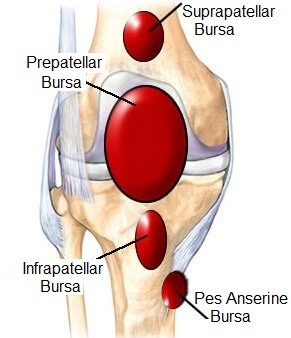
Knee bursa are small fluid filled sacs which contain synovial fluid.
Bursa are found all over the body and there are approximately fourteen around the knee.
They sit between two surfaces, usually muscle and bone, to reduce friction, a bit like ball bearings. This allows everything to move smoothly preventing inflammation.
Sometimes the knee bursa get damaged, known as bursitis, which can cause pain. This is usually when there is excessive friction over the bursa causing it to either become inflamed, or when it dries out so it no longer works properly.
The Main Knee Bursa
So lets have a look at knee bursa anatomy, particularly focusing on the 5 main knee bursa, which are the ones that are most commonly injured. Then we will look at what can go wrong with them.
1. Prepatellar Bursa
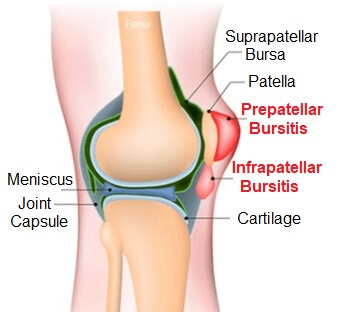
The prepatellar knee bursa is found directly in front of the kneecap, just underneath the skin. It provides protection and cushioning for the kneecap
Repetitive or prolonged, forwards kneeling places a great deal of pressure and friction on the prepatellar knee bursa which can lead to inflammation.
Inflammation here is known as prepatellar bursitis, or Housemaids Knee. It commonly affected people who spend lots of time kneeling and today is more common in trades such as roofers and carpet fitters than housewives!
2. Infrapatellar Bursa
There are actually two infrapatellar knee bursa, known as the deep and superficial infrapatellar bursa.
They are both found just below the kneecap protecting the patellar tendon and the tibial tuberosity, a bony prominence where the patellar tendon attaches to the tibia.
Inflammation of either of these knee bursa is known as infrapatellar bursitis, or Clergyman's Knee. These knee bursa also tend to cause problems for people who kneel lots, but is usually caused by more erect kneeling than with prepatellar bursitis - visit the infrapatellar bursitis section to find out more.
3. Pes Anserine Bursa
The Pes Anserine knee bursa is found on the inner side of the knee approximately two inches below the joint between the tendons of the sartorius, gracilis and semitendinosis muscles and the medial collateral ligament.
Inflammation of Pes Anserine is especially common in runners and swimmers - visit the pes anserine bursitis section to find out more.
4. Semimembranosus Bursa
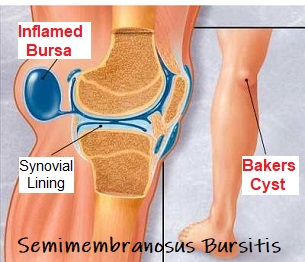
The semimembranosus bursa is found at the back of the knee. It sits between one of the hamstring muscles (semimembranosus) and the medial head of one of the calf muscles (gastrocnemius).
Inflammation of this knee bursa is known as semimembranosus bursitis, or, more commonly, a Bakers Cyst, which can be extremely painful.
A Bakers cyst usually develops when by excess fluid in the knee, usually from an injury or arthritis, leaks back into the bursa causing it to swell. A lump forms behind the knee, like a squashy orange.
5. Suprapatellar bursa
The suprapatellar knee bursa is found above the kneecap. It sits underneath the quadriceps tendon at the bottom of the thigh just allowing the quadriceps to glide up and down on the femur as the knee bends and straightens without friction.
Inflammation and irritation is common in people who do lots of running and jumping, or kneel frequently resulting in swelling above the knee - visit the suprapatellar bursitis section to find out more.
Other Knee Bursa
The other bursa knee locations are:
- Anteriorly - front of the knee: pretibial and deep infrapatellar bursa
- Medially - inner side: medial gastrocnemius bursa, the bursa between
semitendinosus tendon and the head of the tibia and occasionally there
is a bursa between the tendons of semimembranosus and semitendinosus
- Laterally - outer side: lateral gastrocnemius, fibular, fibulopopliteal and the subpopliteal bursae
Possible Problems
Problems usually develop in the knee bursa when there is muscle tightness or weakness which causes excessive friction on the bursa and can lead to knee bursitis.
The knee
bursa can become either:
- Inflamed: i.e. swollen known as bursitis or
- Dried out: i.e. they lose the fluid inside them
This results in more friction on the underlying bone and the muscles/tendons leading to bursa knee pain. Usually a combination of strengthening and stretching exercises, medication and injections helps the knee bursa to recover.
Inflammation and irritation of the knee bursa is a common cause of knee pain. To find out more about what can go wrong, visit the bursitis of the knee section to find out more about prevention and bursitis treatment.
What Next?
There are a number of other structures in and around the knee that can cause pain. Your can find more about them:
Alternatively, if you have a problem with your knee and would like help working out what is causing it, visit the knee pain diagnosis section.
Page Last Updated: 05/10/23
Next Review Due: 05/10/25
